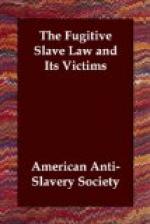JAMES TASKER, New York City, (Feb. 1852,) arrested through the treachery of Police Officer Martin, and brought before United States Commissioner George W. Morton, as the slave of Jonathan Pinckney, of Maryland. He was given up, and taken back to slavery.
HORACE PRESTON, arrested in Williamsburg, New York, as the slave of William Reese, of Baltimore, Maryland;—Richard Busteed, of New York, being Attorney for the slaveholder. He was brought before United States Commissioner Morton, 1st April, 1852; for several days previous he had been kept a prisoner, and his wife knew not what had become of him. He was given up by the Commissioner, and was carried into slavery. The same policeman, Martin, (who acted in the case of James Tasker,) was active in this case; being, doubtless, the original informant.
Preston was afterwards
bought for about $1,200, and brought
back.
Columbia, Penn., (end of March, 1852;) a colored man, named WILLIAM SMITH, was arrested as a fugitive slave in the lumber yard of Mr. Gottlieb, by Deputy Marshal Snyder, of Harrisburg, and police officer Ridgeley, of Baltimore, under a warrant from Commissioner McAllister. Smith endeavored to escape, when Ridgeley drew a pistol and shot him dead! Ridgeley was demanded by the Governor of Pennsylvania, of the Governor of Maryland, and the demand was referred to the Maryland Legislature.
Hon. J.R. Giddings
proposed the erection of a monument to
Smith.
JAMES PHILLIPS, who had resided in Harrisburg, Penn., for fourteen years, was arrested May 24, 1852, as the former slave of Dennis Hudson, of Culpepper County, Virginia, afterwards bought by Henry T. Fant, of Fauquier County. He was brought before United States Commissioner McAllister. Judge McKinney volunteered his services to defend the alleged fugitive. The Commissioner, as soon as possible, ordered the man to be delivered up; and, after fourteen years’ liberty, he was taken back to slavery in Virginia. Afterwards, bought for $900, and taken back to Harrisburg.
Wilkesbarre, Penn.,
(Summer of 1852.) Mr. Harvey arrested
and fined for shielding
a slave.
Sacramento, California; a man named Lathrop claimed another as his slave, and Judge Fry decided that the claim was good, and ordered the slave to be surrendered. Mr. Lathrop left, with his slave, for the Atlantic States.
A beautiful young woman, nearly white, was pursued by her owner [and father] to New York, (end of June, 1852.) There a large reward was offered to a police officer to discover her, place of residence. It was discovered, and measures taken for her apprehension; but the alarm had been taken, and she escaped.
Sacramento, California; three men were seized by a Mr. Perkins, of Mississippi. The Court decided them to be his property and they were carried back to Mississippi.—Standard, July 29, 1852.
Petersburg, Penn.
Two fugitives from Alabama slavery were
overtaken, and taken
back, September, 1852.




